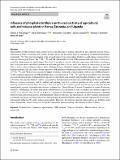| dc.description.abstract | Three brands of NPK fertilizers that contain variable concentrations of natural radioactivity are commonly used in tobacco
plantations in Kenya, Tanzania, and Uganda. Tobacco plants are known for hyper-accumulation of natural radionuclides,
particularly 238U. This study investigated if the elevated radioactivity in phosphate fertilizers could enhance radioactivity in
soils and tobacco plant leaves. The 232Th, 238U, and 40K radionuclide levels in NPK-fertilized soils and tobacco leaves were
measured using gamma-ray spectroscopy. The research included a one-year reference experiment with tobacco growing in
plots, a ten-year semi-controlled experiment in well-managed tobacco farms, and a field survey of radioactivity in soils and
tobacco leaves at three traditional tobacco fields in Migori (Kenya), Urambo (Tanzania), and Kanungu (Uganda). The findings
demonstrated that soils and tobacco leaves exposed to NPK fertilizers with increased radioactivity had activity concentrations
of 232
Th, 238
U, and 40
K that were considerably higher (at all sites) than in the control samples (with no use of NPK fertilizers).
As the continued application of NPK fertilizers raises concentrations of 232Th, 238U, and 40K in agricultural soils, the study
assessed radiological risks for humans from exposure to agricultural soils enriched with phosphate fertilizers, and it was found
to be below the exposure limit of 1 mSvy-1 suggested by the International Commission on Radiological Protection (ICRP).
However, tobacco consumers, both by snuffing and smoking, may face significant radiological risks, as the snuffing and
smoking resulted in effective doses that were 2.41 to 6.53 and 1.14 to 2.45 times greater than the average yearly dose that the
general public receives from inhalation of natural radionuclides (United Nations Scientific Committee on Atomic Radiations
estimates). Furthermore, the results indicate that the lifetime excess cancer risk for tobacco snuffers and smokers ranged from
5 × 10 -5 to 24.48 × 10 -3 and 2.0 × 10 -5 to 9.18 × 10 -3 , respectively. The influence of phosphorus-derived fertilizer containing
relatively high natural radioactivity, potential human radiation exposure, and radiological risk due to gamma radionuclides
is estimated and discussed. The results reveal that applying phosphate fertilizers enhances natural radioactivity in soil and is
subsequently influenced by soil to tobacco plant uptake. Therefore, the study recommends that countries use fertilizers with
lower radionuclide content to conserve soil quality and reduce gamma-emitting radionuclides in tobacco plants. | en_US |

